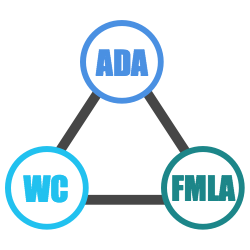The Bermuda Triangle of Labor Law
The confusing connections between ADA, FMLA & workers’ comp.

There is no shortage of labor laws for employers to wrap their minds around – in fact, there are more than 180 federal employment laws administered and enforced by the U.S. Department of Labor alone, and that doesn’t begin to include the many other laws enforced by other federal agencies or the hundreds of employment laws on the state and local levels.
To really get a hold on the many federal laws, you’d have to spend years researching and reading rules and regulations. If you’re looking for a place to start your dive into labor law compliance, however, there’s no better place than the Bermuda Triangle.
(Wish someone could just tell you what you need to know about labor law compliance? Just check out our “HR Alphabet Soup” webinar.)

Wait… the Bermuda Triangle?
Not the real Bermuda Triangle, of course. In this context, the Bermuda Triangle is the name given by some HR professionals to three of the most closely interconnected components of labor law: ADA (Americans with Disabilities Act), FMLA (Family and Medical Leave Act) and WC (workers’ compensation). Each of these laws/regulations covers employee leave in some way and, often, two or all three may apply to the same situation. If employers aren’t careful, they can easily find themselves swept up in these turbulent waters and facing some stiff penalties for HR noncompliance.
Navigating the “Bermuda Triangle”
The key to navigating the confusing waters of ADA, FMLA and workers’ compensation is understanding both the fundamentals of each law on its own and how these laws work together.
Below are some basics to help employers familiarize themselves with each element of this particular Bermuda Triangle:
ADA: Americans with Disabilities Act
The Americans with Disabilities Act prohibits discrimination against people with disabilities and guarantees that they have equal opportunities in matters of employment. Employers with 15 or more employees are required to comply with the ADA, although employers of all sizes are also encouraged to comply with ADA rules and regulations as well.
People who are protected by the ADA include people who:
- Have a physical or mental impairment that substantially limits one or more major life activities;
- Has a history or record of such an impairment; or
- Is perceived by others as having such an impairment or disability.
The ADA requires covered employers to go through in what is known as the “interactive process.” The purpose of the interactive process is to have employers and employees engage in conversation to discuss possible reasonable accommodations that can be made to enable the employee to perform the essential functions of the job. Employers are required to provide reasonable accommodations to qualified employees with disabilities, unless doing so would pose an undue hardship for the company. It’s important to note that inconvenience is not the same as an undue hardship under the ADA.
If an employer refuses to engage in the interactive process and/or fails to make reasonable accommodations, they may be leaving themselves open to claims of ADA noncompliance.
FMLA: Family and Medical Leave Act
The Family and Medical Leave Act provides eligible employees with 12 workweeks of unpaid leave to care for themselves (or a family member) in the event of a serious health condition. Upon return from leave, FMLA requires that the employee must be restored to his or her original job, or to a job with equivalent pay and benefits. The Act also ensures that health benefits for employees taking FMLA leave are maintained as if he or she had continued work. Employers who employ at least 50 employees within a 75-mile radius are required to comply with FMLA regulations.
To be eligible for FMLA leave, an employee must:
- Work for a covered employer at a location in the U.S. that employs at least 50 employees within a 75-mile radius;
- Have worked for that employer for at least 12 months; and
- Have worked at least 1,250 hours in that 12-month period.
Employers that interfere with or deny an employee’s rights under FMLA, or that discharge or discriminate against an employee due to any activity related to FMLA leave, put themselves at serious risk of claims for FMLA noncompliance.
WC: Workers’ Compensation
Workers’ compensation is largely regulated on a state-by-state basis, although there are some federal WC regulations that are enforced on the federal level by the Office of Workers' Compensation Programs (OWCP).
Most workers’ compensation laws are similar in that they require employers to provide certain benefits (medical expenses, death benefits, lost wages, vocational rehabilitation, etc.) to employees who suffer a work-related injury or illness, although specific amounts and eligibility requirements may vary across different jurisdictions.
In the majority of states, employers meet their obligation to provide workers’ compensation by purchasing workers’ compensation coverage from an insurance carrier. (A few states, however, require workers’ comp coverage be secured through state-operated funds. Other states do not establish a requirement to purchase workers’ compensation insurance – most notably, Texas.)
NEXT: What happens when these laws overlap?
Overlap between ADA, FMLA and WC
It’s easy to see, now, how one employee’s leave might be covered under one, two or three of these laws.
Below are a few hypothetical situations to highlight the overlap between these laws:
Workers’ compensation + ADA
If an employee is injured in a work-related accident, they may be entitled to benefits provided under workers’ compensation. If that employee develops a disability that limits a major life activity as a result of that injury, he or she might also then be protected by the ADA. If this is the case, the employer should make sure to go through the interactive process with the employee to determine what/if any reasonable accommodations might need to be made.
FMLA + ADA
If an employee sustains an injury or develops a serious health condition that is unrelated to work, he or she might be entitled to take up to 12 workweeks of job-protected leave to care for themselves under FMLA. If that condition also limits a major life activity, he or she may also be protected by the ADA.
WC + FMLA + ADA
If an employee sustains a work-related injury that substantially limits one or more major life activities and needs to take leave to care for themselves, he or she might be protected by all three laws.
It is largely the employer’s responsibility to understand how these laws may apply and ensure they are acting in compliance with all the applicable laws in any situation. Ignorance of the law is not an excuse.
Do all these acronyms have your head swimming?
Don't stress - you only need to remember two letters: G&A.
G&A Partners provides a lifeline to businesses struggling with employment law and HR compliance, delivering both strategic and tactical human resources support.
G&A's experienced human resources professionals understand the nuances of federal and state labor laws, and so can help your company decode them and expertly execute procedural tasks surrounding government compliance.
